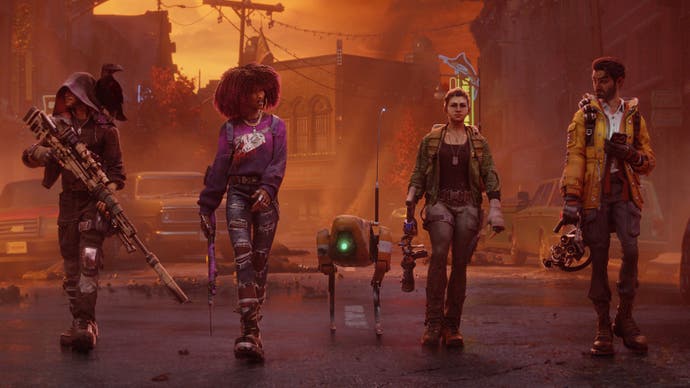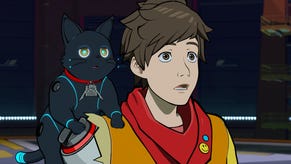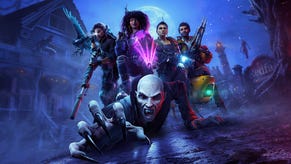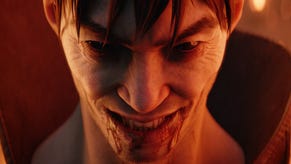One last stroll through Redfall, at the pace it was always meant to be played
Saying goodbye and thanks to one of recent gaming's most intriguing worlds.
Calm seas and sunny skies. I had not been back to Redfall in a while before this week, when events meant I suddenly knew I had to check in again. Spring has finally arrived in Sussex, so when I turned the game on one morning and sat down to play, a warming sun was already slanting in through the windows. The promise of summer! Redfall, of course, worked its spell. On the screen, a US flag hung limply from a pole against louring skies, while a stray breeze gathered and then scattered dry leaves, eddying, dithering, round and round. It was like stepping out on an Autumn evening. October Country. Everything that I wanted.
My idea was just to wander. Like a lot of people I struggled with Redfall as a fast-paced co-op action game, because it so clearly didn't want to be a fast-paced co-op action game. In my mind, perhaps unfairly, I see the pitch that I imagine was handed down from above as being something like: can you get us Stranger Things and Left 4 Dead in a single package? Arkane Austin was - feels weird and grim to say "was" - a famously smart bunch of people. I cannot believe the team didn't know where its strengths lay. Its strengths lay in slowing down, savouring the environmental storytelling and tactical options. Slow down, and this is still the game that Redfall is - the storytelling part at least. But you have to play across the game design to see it. You can't meet it head on. You have to go hunting for the magic, ducking around the gunfights, which are fine, and the bottlenecks they create. But the magic is here waiting for you.
My favourite moments playing Redfall the first time around were all on the first of two open-world maps. I loved the locations that spoke to a realistic, slightly up-itself seaside town in New England. There were boss fights and magical-realism moments in which you travelled inside a doll's house, but I preferred finding the gorgeously restored old cinema, itself a kind of doll's house contrivance with its brass railings and tip-up seats and classic movie posters. My favourite bit of storytelling wasn't about how vampires had taken over and messed with the sun. It was about a safe house that had once been a painfully contemporary smoothie bar where influencers could film themselves drinking luminous protein-and-berry blends filled with activated almonds.
Now, on the second map, I set off in search of that kind of thing. And spoilers: I spent a very happy morning just wandering in Redfall, reminding myself how much special stuff is in here, just lying around, waiting for you to see it. I played the game not like Left 4 Dead, not even like Dishonored, but like it was a variant on Dear Esther or Everybody's Gone to the Rapture, but with a weird bug that meant sometimes the diorama you were moving through took pot-shots at you and yelled about flanking. It was great. I wandered past a covered bridge, beautifully rendered with that special spidery gloom inside it. I peered in the window of a restaurant that still had its grand opening sign up on the clapboard, but also had a scrawled note in a window that said: TAKEOUT ONLY. Takeout during a vampire apocalypse! Redfall was really pulling together.
In need of some kind of objective for my wandering I decided to head out and unlock a bunch of fast travel points that I would never conceivably use. I set markers on the map and wandered back and forth through the rosy dawn, while the Eerie Indiana soundtrack plucked away, surprisingly light and mischievous - I had forgotten that. I wandered past the kind of barn you see in Christmas movies. I pottered along cliffside tracks and marvelled at how the team had controlled sight-lines to get a real variety of locations into a single map, ostensibly of an East Coast small town. Everywhere there was a name that hinted at community and slight satire - I detected backstories in the orchard, and in the power plant that had now become a safe house. Safe houses in Redfall were always ripe with narrative to uncover.

I thought for a while that I had found an emblematic moment - the game that Arkane made so well, fighting against the Game Pass action-packed live service thing - when halfway through an accidental gunfight I stopped to read a flyer on the floor that told me about a local rehab centre. But I don't think that's fair. The emblematic moment was back at the hub for this map, which is a beautifully observed maritime centre, with glossy displays and ramps leading up to exhibitions in the loft, while down below there's a suite of nautical-themed guestrooms.
In one of these, when idly respawning at some point, I found a really lovely mini-narrative about a whaling ship that had encountered pirates, and then had stopped, mid-battle, to deliver the pirate captain's baby. Lovely stuff. I loved the various nautical prints, too. And like every post-apocalyptic game, the chintz and domestic clutter was undercut by notes of horror - bloodstained arcs on the ground as if something dead and bleeding had been dragged over the polished floorboards.
Lots of teams would have thought of that. But then I looked up and saw an ominous stain on the ceiling, suggesting something huge and bad and very real bleeding through into this posh maritime idyll. A stain on the ceiling. How many teams would have thought of that?
It's hard to play Redfall, particularly now, without trying to separate what I imagine the team wanted and what came down from above. Really, it's pointless to bother with that. But the thing that struck me the most about returning to Redfall? Well, there were two things. The first was a reminder of what a brilliant, rich, multilayered place Arkane had built, how clearly it had seen this part of the world and then recreated it, with one eye on satire but another on the integrity of what this part of the US is like and its strange literary heritage.
The second thing was a lot sadder. I'm not the first to make this point, but I hope it bears repeating: in life, in art, you learn a lot more from the things that go wrong than you do from the things that go right. Regardless of Microsoft's involvement with the things that went wrong here - and I can't help but imagine that involvement was fairly extensive - it seems so deeply wrong to cut the team loose. In general, of course, but also when there was so much fascinating, endlessly promising stuff to learn and build on. Goodbye Redfall. I had fun, and I would have loved to have been there for what came next. Day one.










